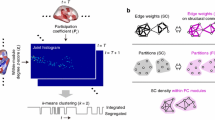Abstract
The topography of human functional brain network not only differs between individuals but also reconfigures according to the specific brain state. However, it remains unknown how the fine-grained functional boundaries change in different individuals and states. Instead of using within-parcel features, we proposed an avenue to directly investigate the individual boundary differences and state-specific reconfigurations of functional topography using the boundary mapping method. By quantitatively calculating the inter-subject and intra-subject boundary variation rankings of different states and networks, we observed that the individual variation of functional boundaries is higher in the resting state compared to other task states, and is particularly variable in high-order association networks. In addition, we also proved that the parcel boundaries within individuals are significantly more similar than those between individuals from the view of boundary variation. Our results reveal the spatio-temporal distribution of the inter and intra individual functional topography variations and emphasize the importance of considering the individualized functional parcellation for understanding the dynamic of brain organization.
Funded by the Beijing Advanced Discipline Fund, the Strategic Priority Research Program of Chinese Academy of Sciences (XDB32030200) and the National Natural Science Foundation of China (61703302).
Access this chapter
Tax calculation will be finalised at checkout
Purchases are for personal use only
Similar content being viewed by others
References
Cole, M.W., Bassett, D.S., Power, J.D., Braver, T.S., Petersen, S.E.: Intrinsic and task-evoked network architectures of the human brain. Neuron 83, 238–251 (2014)
Salehi, M., Greene, A.S., Karbasi, A., Shen, X., Scheinost, D., Constable, R.T.: There is no single functional atlas even for a single individual: functional parcel definitions change with task. Neuroimage 208, 116366 (2020)
Gratton, C., et al.: Functional brain networks are dominated by stable group and individual factors, not cognitive or daily variation. Neuron 98, 439–452 (2018). e435
Eickhoff, S.B., Yeo, B.T.T., Genon, S.: Imaging-based parcellations of the human brain. Nat. Rev. Neurosci. 19, 672–686 (2018)
Fan, L., et al.: The human brainnetome atlas: a new brain atlas based on connectional architecture. Cereb. Cortex 26, 3508–3526 (2016)
Gordon, E.M., Laumann, T.O., Adeyemo, B., Huckins, J.F., Kelley, W.M., Petersen, S.E.: Generation and evaluation of a cortical area parcellation from resting-state correlations. Cereb. Cortex 26, 288–303 (2016)
Zuo, N., Yang, Z., Liu, Y., Li, J., Jiang, T.: Both activated and less-activated regions identified by functional MRI reconfigure to support task executions. Brain Behav. 8, e00893 (2018)
Yeo, B.T., et al.: The organization of the human cerebral cortex estimated by intrinsic functional connectivity. J. Neurophysiol. 106, 1125–1165 (2011)
Glasser, M.F., et al.: The minimal preprocessing pipelines for the Human Connectome Project. Neuroimage 80, 105–124 (2013)
Author information
Authors and Affiliations
Corresponding author
Editor information
Editors and Affiliations
Rights and permissions
Copyright information
© 2020 Springer Nature Switzerland AG
About this paper
Cite this paper
Zhang, Z., Xu, J., Cheng, L., Chen, C., Fan, L. (2020). Inter and Intra Individual Variations of Cortical Functional Boundaries Depending on Brain States. In: Yang, H., Pasupa, K., Leung, A.CS., Kwok, J.T., Chan, J.H., King, I. (eds) Neural Information Processing. ICONIP 2020. Lecture Notes in Computer Science(), vol 12534. Springer, Cham. https://doi.org/10.1007/978-3-030-63836-8_9
Download citation
DOI: https://doi.org/10.1007/978-3-030-63836-8_9
Published:
Publisher Name: Springer, Cham
Print ISBN: 978-3-030-63835-1
Online ISBN: 978-3-030-63836-8
eBook Packages: Computer ScienceComputer Science (R0)




